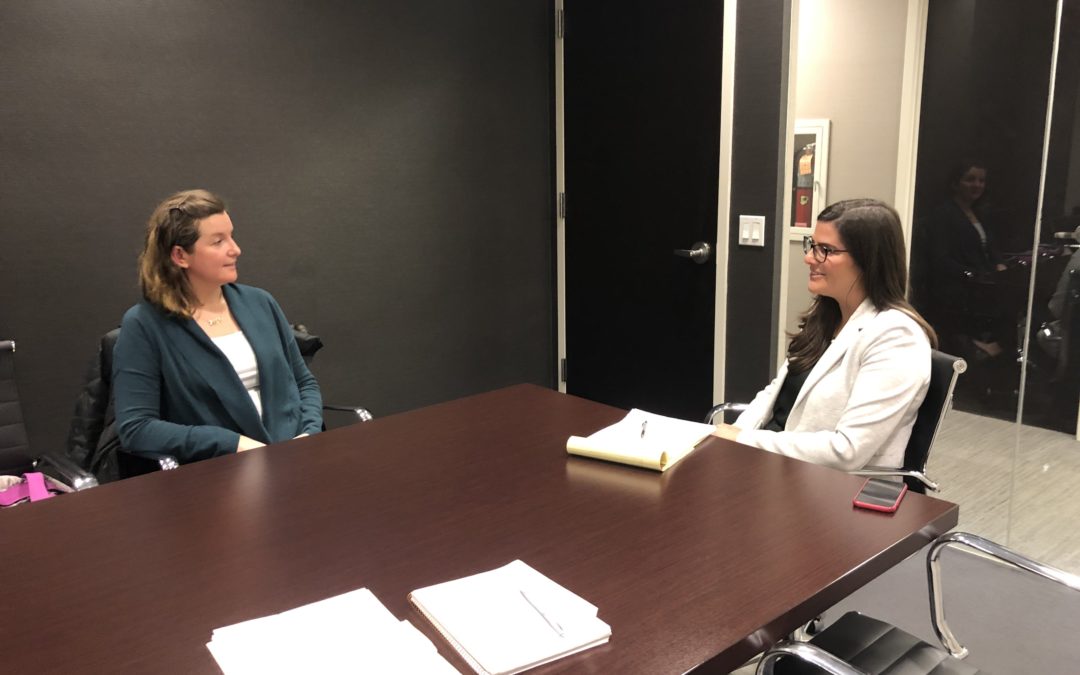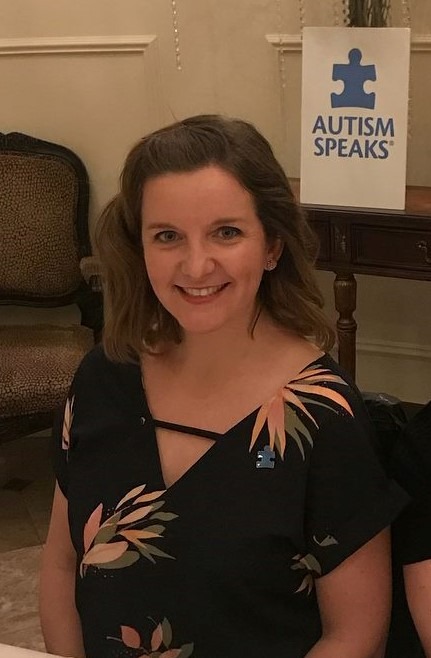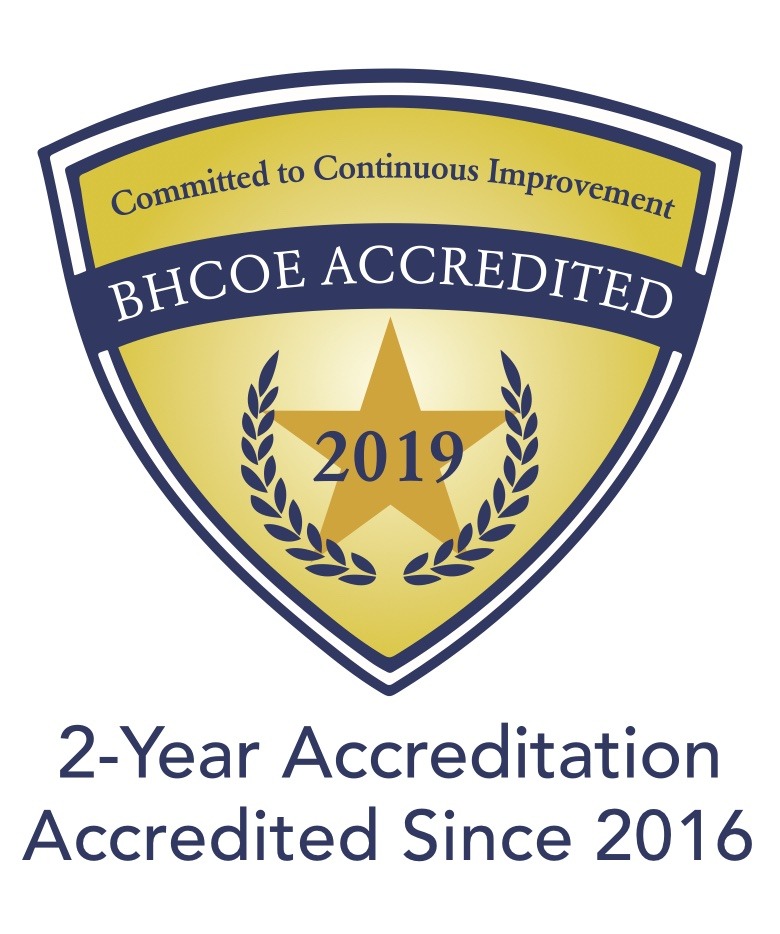
by admin | Mar 28, 2019 | ABA Therapy, Company News, Interviews
Patricia Rollins (left) and Kaitlin Causin (right)
About Trish
Patricia “Trish” Rollins is the NYC Field Development Manager for Autism Speaks. Trish originally got involved with Autism Speaks in 2007 as a volunteer. She has a brother on the spectrum, and wanted to do something bigger and outside of her family, so she volunteered with Autism Speaks.
She participated in her first walk in 2008, and very quickly decided that this was something she really wanted to get involved with in a meaningful way. She joined up with the NYC walk committee to have a deeper involvement in the cause, and when the Staten Island walk committee was formed in 2012, she joined up with that committee as well. A temporary position with Autism Speaks opened in 2014, and of course she took it, and later a permanent position in 2015, which she continues to hold today.
Trish has an organic connection to the organization. She has a unique perspective on Autism Speaks having been involved as a family member, a volunteer, a committee member, and a finally as a full-time employee. She has seen the walks as a volunteer and participant, and lends that perspective to the planning of the walks.
Trish sees herself as an Autism Speaks lifer. It is a rarity these days, but she is one of the lucky few who wakes up every day and genuinely loves going to work. She feels a strong connection to the families that she works with and speaks with on a daily basis. This is especially true at walks and events where she gets to meet the people that she helps face-to-face and to hug the kids and see them having a good time.
Autism Speaks: Mission and Vision
Autism Speaks’ mission and vision is undergoing a shift from autism awareness to autism understanding and acceptance. Awareness is important, but even more important is developing a better understanding and acceptance of autism and those affected by autism because that is what leads to individualized treatment and specialized care.
World Autism Awareness Day & World Autism Month
Autism Speaks put autism on the map, and World Autism Awareness Day and World Autism Month are key awareness drivers.
The 12th annual World Autism Awareness Day is April 2, 2019, and is one of seven health related UN world days. Joined by the international community, hundreds of thousands of landmarks, buildings, homes and communities around the world will “light it up blue on April 2” in recognition of people living with autism.
Individuals who want to “Light it Up Blue” can get involved in the following ways:
- Wear blue: Wear something blue on April 2 in support of understanding and acceptance for people with autism. You can get official #LightItUpBlue gear at the Autism Speaks e-store. Many schools and businesses participate in dress down days where students/faculty/employees wear blue.
- Light blue: Get BLUE Philips light bulbs at Home Depot, or visit rosco.com/LIUB to get blue light filters. A portion of sales goes to Autism Speaks, and you have an easy way to light your house up blue!
In addition, there are many ways to show your support and spread the word on social media. Click here to learn how to Share Blue, Spread Blue, and Support Blue on World Autism Day, and throughout April, which is World Autism Month.
World Autism Month features autism-friendly events and educational activities designed to increase understanding and acceptance and foster worldwide support.
We asked Trish what makes World Autism Month so special and she shared that it is a time when Autism Speaks hears from a lot of the families. It’s a time for everyone to share their own personal stories. There is a mosaic on the website where families can share pictures and stories about themselves and their children. It provides these families and individuals a great opportunity to share their stories in one big space and to truly see and understand that there is a community out there.
Visit https://www.autismspeaks.org/world-autism-month for events and resources, and to learn how you can get involved.
History of Autism Speaks and the Walks
The organization was started in 2005 by Suzanne and Bob Wright who were inspired by their grandson who was diagnosed with autism. The Wrights helped raise funding for research, advocacy and extensive family services. They also led initiatives that affected change in insurance reform, began a public service campaign, started World Autism Awareness Day, and Mrs. Wright also helped launch the iconic blue puzzle-piece logo now recognized around the world.

Patricia Rollins of Autism Speaks
Recalling the time that she first met Mrs. Wright, Trish remembered her as a force to be reckoned with who did not take no for an answer:
“Suzanne set the bar of the parent advocate. I think she would be proud to see where we are going now.”
Suzanne and Bob Wright are the ones who started the first walk in Palm Beach, Florida. Now, it is always the first walk of the year. Today, there are over 70 walks that take place throughout the country. Organizations can reach out to the Field Development Team at Autism Speaks to express interest in starting a walk in their own community.
Fundraising is the #1 goal of all of the walks, but a close second according to Trish is that the walks provide families with an opportunity for face-to-face interaction with Autism Speaks staff, service providers, and other families in their local community. People are uplifted after seeing all of the other families. They are provided with a feeling of community, making personal one-to-one connections that develop into sounding boards and even support groups.
Trish’s favorite part of the walk is right at the start. She loves to get a great vantage point where she can see the people holding signs and waving and cheering. It’s like a giant parade and she can and feel the amazing energy that is created by the group.
Resources
Trish feels that the most important resource Autism Speaks offers for parents or individuals is the Autism Response Team (ART) – they are the “boots on the ground” and are there to help answer questions and connect people with autism, their families and caregivers to a wealth of information, tools, and resources.
Aside from the ART team, there are over 40 free downloadable tool kits available on the Autism Speaks website that can be filtered by audience, age range, level of support, and resource type, so you can easily find the specific resource you need. If you would like to check them out, visit the online resource guide with 10,000+ resources – search by zip code and find local resources.
Autism Speaks Walk 2019
Don’t forget: the 2019 NYC Autism Speaks Walk is on Sunday, September 15th at the South Street Seaport Pier 15. Please come down if you are in New York City and experience the walk for yourself! And don’t forget to look for us at our Attentive Behavior Care tent!
If you would like more information on how Attentive Behavior Care can help your child, contact us today!

by admin | Mar 21, 2019 | ABA Therapy, Company News
BHCOE Accreditation is the only ABA-specific accreditation. It provides feedback regarding clinical best practices, staff satisfaction and turnover, and consumer protection.
Acting as a third-party, BHCOE systematically measures and reports on existing quality criteria in the behavior analysis community using standardized methods and practices, and accredits only those service agencies that meet these standards.
What is the BHCOE Accreditation?
 The BHCOE Accreditation is a trusted source that recognizes behavioral health organizations committed to continuous quality improvement. BHCOE offers a third-party measurement system that differentiates and provides independent feedback on clinical quality indicators. The BHCOE criterion features standards that subject-matter experts developed to measure effective applied behavior analysis services.
The BHCOE Accreditation is a trusted source that recognizes behavioral health organizations committed to continuous quality improvement. BHCOE offers a third-party measurement system that differentiates and provides independent feedback on clinical quality indicators. The BHCOE criterion features standards that subject-matter experts developed to measure effective applied behavior analysis services.
Attentive Behavior Care is proud to report that we have received a two-year reaccreditation! BHCOE acknowledged us as a behavioral service provider dedicated to continuous improvement in Applied Behavior Analysis (ABA).
BHCOE Accreditation recognizes behavioral health providers that excel in the areas of clinical quality, staff qualifications, and consumer satisfaction. These areas are measured through a wide-ranging audit, including interviews with agency clinical leadership, in-depth on-site observation, a detailed staff qualification review, anonymous staff satisfaction survey, and anonymous consumer satisfaction survey.
“At Attentive Behavior Care, we are proud to receive BHCOE Reaccreditation because it reflects our commitment to continual growth and improvement. We are thankful for our highly qualified team that makes our reaccreditation possible and aids our clients in making positive behavioral changes,” said Chief Clinical Officer, Kaitlin Causin, M.A., BCBA, LBA (AZ, CT, MA, MD, NY), “We look forward to continuing to provide comprehensive behavior analysis services of the highest quality in New York, New Jersey, Maryland and beyond, for years to come.”
Our Mission Statement
We are very proud to be comprised of behavior technicians, supervisors (e.g., Board Certified Behavior Analysts® (BCBAs®), Licensed Behavior Analysts (LBAs), and a strong administrative team who work together to provide ABA services for individuals with Autism Spectrum Disorders (ASD).
We specialize in providing intensive, individualized, treatment rooted in the principles of ABA in order to meet our patients’ needs. Our treatment plans focus on increasing skills that will lead to increased opportunities, involvement, and independence while simultaneously decreasing problem behavior and other barriers to learning.
It is our mission to decrease the challenges faced and enhance the lives of individuals with ASD and their families by providing one-to-one instruction, group treatment, education, training, guidance, and resources.
Our Core Values
Our practices hinge on the following core values:
1 – Every patient has the right to effective treatment that is rooted in the evidence-based literature of the science of ABA. Treatment must consist of an in-depth assessment to select goals and objectives which target socially significant behavior.
2 – Every patient has the potential to learn new skills and the right to acquire meaningful repertoires measured by a consistent data collection system and systematic review.
3 – Every patient has the right to programming and treatment which increases access to reinforcers, opportunities for rewarding personal relationships, well-being, productivity, independence, and community involvement while decreasing barriers to learning.
4 – Every patient has the right to treatment that is provided within the context of what is legal, ethical, and best practice.
5 – Parents/caregivers have the right to be involved throughout every facet of the assessment, treatment, transition, and discharge process through effective communication and active participation.
6 – Every patient has the right to a treatment team of qualified, highly trained professionals.
For more information about Attentive Behavior Care and how we can help your child, please contact us today.

by admin | Mar 14, 2019 | ABA Therapy, Clinician's Corner, Provider
By: Heyde Ramirez, MA, BCBA, LBA
Am I Making a Difference?
Congratulations! You are officially a Board Certified Behavior Analyst® (BCBA®). The day has finally come, and you’ve been handed your first case. You are excited! After all, imagine all of the possibilities. All of the potential behaviors to shape, increase, and decrease. You have trained for this and you can’t wait. You want above all else to make a difference!
You go and meet your client and their family for the first time. You are professional and courteous. You conduct a skills assessment and go home and develop goals. You are giving this case your all, as you should, and you find yourself devouring the research, ensuring that all of your treatment techniques align with what we know to be evidenced based practice. You create the data sheets. You gather your materials. You feel good, right? A sense of accomplishment that comes with knowing that you are about to change someone’s life envelopes you. You are the team captain, and you have gathered the finest crew available. You have plans to provide ongoing training to the behavior technicians and to your client’s family. You know exactly what to do and where to go as you make plans to lead your team on an expedition that will no doubt take your client on a journey towards independence and a higher quality of life. But are you REALLY making a difference? How do you even begin to answer that question?
Find Out From Others
Well, it’s not the kind of question you can or should answer on your own. Talk to the team, remember, while you may be the BCBA® on this case, you are just one part of this team. Sure, you’ve trained for this and you believe you know what your client needs most, but ultimately you are there to provide a service to your client. Is your client and their family going to be happy with the service rendered? Families have sought out ABA therapy in most instances in order to see the life of their loved ones improved. They want to see a difference. So how do you make that difference? You may have a treatment plan with beautifully written long and short term goals, but are they socially valid?
Social Validity is Everything!
What is social validity? Well plainly put, does anyone care about what you are teaching your client to do? Is it going to better their quality of life? Is the family on board with the goals in the treatment plan and how you plan to achieve those goals? Were the results noteworthy? If social validity is low…well… let’s just say… you may not be making that difference in people’s lives that you strive to make. Social validity is like that secret ingredient of that dish you love so much, and without it, no one is really going to want to go back for seconds.
As a BCBA®, you are in an amazing position, armed with powerful behavior altering tools, and within reason there is probably nothing you can’t train. Be sure to never stop asking yourself if you are making a difference. Be the BCBA® who stops and truly listens for that answer. Whenever possible, ask your client what they want to work on, and when that isn’t possible, rely on trusted caregivers to give you as much information as possible. Use evidence based practices and ensure buy-in from the team.
Remember, treatment plans should be individualized to the client and that includes the treatment techniques used during treatment. Be the BCBA® who spends the time training the entire team to teach the client relevant and functional skills that will make a difference in their lives. Be the BCBA® whose entire team can confidently say, Yes! This is making a great difference in the client’s life!
Are you interested in becoming a BCBA® with Attentive Behavior Care? Apply today!

by admin | Mar 7, 2019 | ABA Therapy, Parent
By: Jonelle Lupero, BCBA, LBA (NY)
Unfortunately, some commonly held beliefs about Autism, which we know to be untrue, still continue. This lack of understanding can make it difficult for people on the autism spectrum to have their condition recognized and to access the support they need, in addition to compounding the worries of the average parent.
The following is a list of 12 myths about autism which aims to expand autism awareness as well as put an and end to any misconceptions.
1. Myth: Autism is Just a Mental Health Disorder
The truth: Autism is a neurodevelopmental disorder that impairs an individual’s ability to communicate and interact with others. There is more than one type of autism caused by different genetic combinations and environmental factors. In children with autism, the brain develops differently to typically developing children, affecting many areas of development.
2. Myth: Autism Only Affects Male Children
The truth: Children with autism grow up to become adults with autism. Boys are much more likely to be diagnosed with autism than girls, with ratios ranging from four boys diagnosed to every one girl (http://autismspeaks.org). Girls with autism are more likely to have stronger social skills than boys with autism at the same level of cognitive functioning, and they are more likely to have stronger social interests. “Being aware of these key differences in boys and girls with higher functioning ASD can help in awareness and identification of girls with ASD” (Audrey Carson, Ph.D., assistant professor of pediatrics-psychology at Baylor).
3. Myth: People With Autism Don’t Experience the Full Range of Emotions
The truth: People with autism may have difficulty expressing emotions, or may express them in a different way. Children with autism experience the full range of emotions. It is common for people with autism to have difficulty identifying and understanding the emotions of others which can lead to misinterpretations.
Children with autism can build skills and learn to respond to other people in ways that are more typical or expected. Children with autism can and do show physical affection but often on their own terms. For some children, typical means of showing affection are more difficult, such as maintaining eye contact and physical contact.
4. Myth: People With Autism Don’t Want Friends
The truth: Most people with Autism do want to have friends, but have difficulty engaging socially with others, which may make it difficult to interact with peers. The social skills required to form friendships often need to be taught clearly to children with Autism.
In contrast to the previously dominant idea that they prefer social isolation, recent studies have demonstrated that most people with ASD want to form relationships with others. (Brownlow, Rosqvist, & O’Dell, 2015)
5. Myth: People With Autism Don’t Have Other Disorders or Conditions
The truth: Although many people with Autism do not have other conditions, many do. Research has shown that people with autism also have co-occurring conditions such as Intellectual Disability, Epilepsy, gastro-intestinal disorders, food sensitivities, allergies, and Fragile X Syndrome.
6. Myth: All People With Autism Have an Outstanding “Savant” Skill
The truth: There’s an iconic moment in Rain Man, in which Dustin Hoffman’s autistic character counts in an instant the exact number of cocktail sticks dropped on the floor by the waitress. In other scenes he demonstrates incredible powers of memory and calendar calculation. The success of this film has helped spread the incorrect idea that all or most people with autism are savants.
Although many people with autism have amazing “savant” abilities such as extraordinary math or musical skills, the reality is that approximately 10% of the autistic population has an extreme talent or genius level gift (according to the Autism Research Institute), the majority do not.
Children with autism have a wide range of IQ scores and skill sets, and every child is different. 31% of children with ASD have an intellectual disability (intelligence quotient [IQ] <70), 25% are in the borderline range (IQ 71–85), and 44% have IQ scores in the average to above average range (i.e., IQ >85).
7. Myth: Vaccinations Cause Autism
The truth: There is no reliable scientific evidence that childhood vaccinations cause Autism. There is evidence that not vaccinating children has led to an increase in preventable diseases.
In 1998 the British pediatrician Andrew Wakefield and his colleagues published a small story in the respected Lancet medical journal that implied that the MMR (measles-mumps-rubella) vaccine plays a causal role in autism. The Lancet paper was withdrawn in 2010, judged to be flawed and untrue. The same year Wakefield was struck off the doctor’s register after being found guilty of dishonesty and professional misconduct. Several large-scale studies have since examined the possibility of a link between MMR and Autism and have found no evidence to support the link.
According to the Autism Society, no single cause (https//www.autism-society.org/what-is/causes) triggers autism.
Studies (https//www.cdc.gov/ncbddd/autism.data.html) also show that genetics and other chromosomal disabilities tend to be linked to autism.
8. Myth: Children With Autism Don’t Speak
The truth: Although some children with Autism may have delayed speech or may not use words to communicate, many have very well-developed speech. In fact, some children may speak earlier than typically developing peers, but may have an unusual style of communication, such as overly formal speech or a strong preference to talk about particular subjects. There is a very wide range of skills and abilities among children with autism in relation to speech.
9. Myth: Children With Autism Are More Aggressive
The truth: As with other children there are those with autism who may shout or hit when they are distressed, but this is certainly not the case for all children with autism. When problem behavior occurs, it is often related to a lack or deficit of alternative skills or difficulties coping in the sensory environment, regulating emotions or communicating needs.
According to the Autism Society (http://www/autism-society.org) people with ASD are more likely to be victims of violence than to perpetrate it.
Challenging behaviors are often a communication of last resort. It is rare for a child with autism to intentionally cause harm to another person.
10. Myth: Autism is Caused by Bad Parenting Style
The truth: In the 1950’s, a theory called the “refrigerator mother hypothesis” arose suggesting that autism was caused by mothers who lacked emotional warmth. Even though we do not yet know the exact causes of Autism, the research that has been conducted supports the view that parenting style does not cause autism.
Because of difficulties with sensory processing and communication, some children with Autism respond negatively to some typical parenting behaviors, such as touch and hugs, and may require direct communication in order to understand others. When parents adapt their behavior to respond to their child’s needs it may appear unusual to others, but it is important not to assume that the parenting style is causing the child’s difficulties.
There is no known single cause for autism spectrum disorder, but it is generally accepted that it is caused by abnormalities in brain structure or function. Brain scans show differences in the shape and structure of the brain in children with autism compared to in neurotypical children. (autism-society.org)
11. Myth: We Are in the Midst of an Autism Epidemic
The truth: Prevalence in the United States is estimated at 1 in 59 births. (CDC, 2018,) Prevalence of autism in U.S. children increased by 119.4 percent from 2000 (1 in 150) to 2010 (1 in 68). (CDC, 2014)
While it is true that autism diagnoses are on the rise, it doesn’t necessarily mean that there are more cases of autism than there have been in the past. The increase is better explained by a broader definition of autism and more efficient diagnostic methods.
Before 1980, autism wasn’t considered a diagnosis, but a trait of schizophrenia. Over time, the Diagnostic and Statistical Manual for Mental Disorders (DSM) has expanded its description of autism, and it has reduced the number of traits that doctors need to identify in patients in order to diagnose them as autistic.
An autism diagnosis has been expanded to include all spectrum disorders which covers a wide variety of symptoms, severities, and conditions.
In addition, since the late 1980’s and early 1990’s, awareness has also increased over time; more paents, pediatricians, and educators are learning to recognize the early signs of autism and are more likely to seek an Autism evaluation.
12. Myth: Autism Can be Cured With Medicine
The truth: Autism is a life-long disorder; it cannot be cured with medicine. While there is no known cure for autism, there are treatment and education approaches that can address some of the challenges associated with the condition. Intervention can help to lessen disruptive behaviors, and education can teach self-help skills for greater independence. But just as there is no one symptom or behavior that identifies people with autism, there is no single treatment that will be effective for everyone on the spectrum. Individuals can use the positive aspects of their condition to their benefit, but treatment must begin as early as possible and focus on the individual’s unique strengths, weaknesses and needs. (autism-society.org)
According to Autism Speaks (https//www.autismspeaks.org), “We do know that significant improvement in autism symptoms is most often reported in connection with intensive early intervention.
On the other hand, medication can be used to deal with gastrointestinal disorders or problem behaviors that are caused due to autism.
References:
For more information or to discuss how Attentive Behavior Care can help your child, contact us today!






